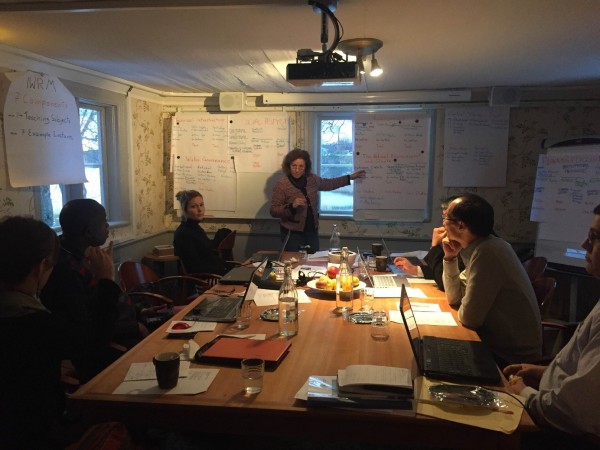It takes a lot of coffee, innumerable flip charts, face to face meetings, long hours of concentration, textual analysis, and sharing experiences. Two GWP interns share their experience of the workshop that finalized GWP’s IWRM ToolBox Teaching Manual.
By Sarah Perrine and Mario Roidt

Over the past few years, GWP’s Knowledge Management Team conducted 12 workshops to show educators how to use the GWP IWRM ToolBox as a teaching resource. Over 170 university lecturers from 61 universities attended the workshops and completed a survey to help GWP improve the IWRM ToolBox. Three findings were unanimous: (i) The ToolBox is widely used in university education already, (ii) the most popular feature of the ToolBox are the case studies and (iii) there is a need for a manual to guide lecturers in using the ToolBox, specifically the Tools and Case Studies to complement curricula and teaching methods.
In response, GWP collaborated with five professors from GWP´s Partner network to create the IWRM ToolBox Teaching Manual. The professors involved come from universities in Panamá, Brazil, China, Zimbabwe, and Kazakhstan and have thorough experience teaching IWRM and using the ToolBox. The concept of the Teaching Manual was conceptualized within GWP, but it’s the professors that contribute their experiences, lessons learned, teaching anecdotes, and sample lectures. The purpose of the manual is to provide a handy, online source of study materials to lecturers teaching water-related courses.
The final Workshop (really, a writeshop) to put the manual together started on a snowy Sunday in Stockholm. We met the professors in the lobby of the hotel before sitting down to breakfast together. While socializing, the names we’d seen so regularly in emails and publications came to life as we connected professional biographies to faces and mannerisms. For the past four months, we had been in regularly contact with five professors to compile their expertise and experiences to create a teaching manual.
The day was long, with conversations on how to break down the complex concept of IWRM into tangible components. We decided on 6: The Environment and Climate Change, Social Aspects, Water Governance, Economics, Planning and Decision Making, and Technical Infrastructure. Within each component we included more detailed Teaching Subjects as diverse as “International Water Law”, “Ecology” or “Assessment Instruments” all connected to the IWRM components. Using this format, a lecturer will be able to easily choose a component and review the teaching subjects to determine what is most appropriate to add in their course. We then continued to review, discuss and adapt already written chapters of the Teaching Manual, streamlining and transforming it into a consistent product.

On Monday, the concepts and texts where becoming clear and tangible. Because the professors are such an erudite group, we picked their brains on IWRM education during the afternoon. We invited GWP staff and external guests to listen to presentations – under the title “Can IWRM be taught?” – which showcased challenges and opportunities faced by professors when teaching IWRM.

Dr. Jean-Marie Kileshye Onema showed how WaterNet creates the opportunity for students to study an IWRM Masters course in different countries in the SADC Region. After students complete their core module in Zimbabwe or Tanzania, students choose a specialized program that continues in one of the other 7 Universities in SADC countries that are part of the programme.
Prof. Dr. Barbara Janusz-Pawletta heads the IWRM Masters course at the German-Kazakh University in Almaty. She is on her way to linking academia, government, and private sector in a new learning philosophy by closing gaps between them.
Prof. Dr. Yiqing Guan provided an overview of Hohai University of China and their role in advancing research and the practice of Hydrology and Hydraulic Engineering.
Prof. Dr. Carlos Saito presented Concept Maps, a teaching approach that gives students the opportunity to understand different water related concepts such as IWRM, Water Security, or the Human Right to Water, by connecting them in concept maps.
Prof. Dr. José Fábrega, who is educating hydraulic engineers in Panamá, shared with us the importance of teaching engineering students that technical solutions are never isolated but are interconnected with institutional, political, and social issues – a challenge he solves by using the IWRM ToolBox.
The seminar was informative, providing information about the reality of teaching IWRM in five different contexts. We concluded the workshop with a quick wrap-up, a timetable for further tasks, and final goodbyes. Off we went our divergent ways into the snowy, dark cold of Stockholm with the warm contentment of having had a week’s worth of experiences – although it was only Monday.



